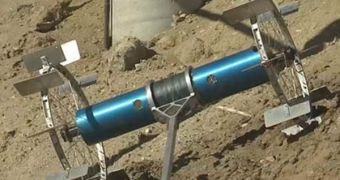The American space agency really outdid itself with the latest development in rover technology. Placed alongside Spirit or Opportunity, Axel, the newest member of the family, looks nothing like its predecessors. For one, it's very, very small, and it is not designed to walk on its own. Rather, it resembles a larger yo-yo that can be attached to a “mother-rover,” and launched whenever the situation asks for it.
The main reason why Axel was created was to offset the difficulties that Spirit and Opportunity had to face when trying to explore the craters of Mars. Every time they met a smaller or larger hole in ground, they couldn't go in and explore, as the control team feared that their solar arrays would become deprived of sunlight, or that they might not be able to get out afterwards. So they came up with Axel, which they call a “tethered marsupial rover.”
Basically, when the carrying rover reaches the edge of a crater NASA wishes to explore, it releases Axel from its holding bay, and then gravity does the rest. The small probe spins to the bottom of the crater, and then uses onboard stereoscopic cameras to photograph the surroundings in detail. A small robotic arm helps it gather soil samples as well. After the mission is complete, Axel has the ability to wind itself up the line that attaches it to the larger rover.
Once it reaches its holding bay, it unloads its cargo, and can then be stored for later use. Such degree of mobility would mean that distances Spirit and Opportunity “walk” in months could be covered in a matter of minutes, as the new device doesn't need to carefully plan its moves around every rock.
“Right now, it's really risky for astronauts or robots, for example, like Spirit and Opportunity to go into craters. The ground is too loose and the slopes are too steep. So it's too risky for those robots to get into those craters and perform any interesting science. So this robot would be very useful for those types of scenarios, where you can really dive into those craters, pick up some samples, and really analyze them and tell us something really new and interesting about Mars or the moon, for example,” says CalTech student Pablo Abad-Manterola, who contributed to Axel's design.
“Axel can readily support different wheel types and sizes ranging from large foldable wheels to inflatable ones. In this way, it can traverse steep and rocky terrains, and tolerate strong impacts during landing or driving. Additionally, Axel is designed with co-location of its sensors, actuators, electronics, power, and payload inside the central cylinder. This configuration provides compactness for launch, and robustness against environmental extremes in planetary missions,” he concludes.

 14 DAY TRIAL //
14 DAY TRIAL //